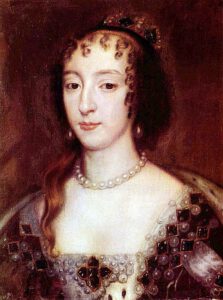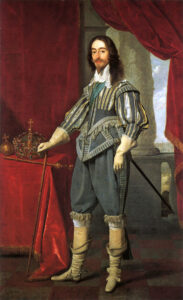Charles I.
*11/1600
†01/1649
Parents
Father: James VI.
Mother: Anna of Denmark
Marriage
Henrietta Marie de Bourbon, Daughter of Henry IV. of France
Children
4 Son´s
5 Daughter´s
Coronation
02/1626 in Westminster Abbey
Regency
03/1625 to 1649
As his Father James VI. as James I. ascended the english Throne, he took three-year-old Charles to London.
After the planned Alliance with the german Protestant Union failed by a Marriage of his Sister Elisabeth with the palatine Elector Friedrich V., a Marriage between Charles and Maria Anna of Spain was agreed. At the same time, this would have prevented a french-spanish approach, the House Stuart upgraded and improved by the dowry of the State Budget. This project also failed when Spain on a visit from Charles in November 1623 demanded his conversion to Catholicism.

Already in November 1616 -after the sudden Death of his older Brother Henry- Charles was appointed heir to the Throne of Scotland and England and followed his Father in March 1625 as Charles I. on the throne. Through his Marriage to the catholic Daughter of the french King Henry IV. Henriette Marie de Bourbon and his coronation service -which was carried out by five Bishops in Dresses of gold and blue Silk- it seemed as if one would return to Catholicism. In fact, Charles, with the Archbishop of Canterbury, rigorously enforced the protestant, anglican (actually anglo-catholic) Church through Censorship, Arrest warrants, Expropriations, and Expulsions.
Quarrel with the parliament
Charles’s foreign policy became more aggressive, sparking a War with Spain.
He even issued Coercive Letters that allowed to raid spanish Ships. Since he needed funds for this War, he convened the Parliament together, but contrary to the usual, it approved an import of the Harbor Duties only for a year, instead of for the entire term of office. They feared Charles, like his Father, would insist on Sole Sovereignty in divine right. Charles then dissolved the Parliament.
When Charles needed new Money, he summoned the Parliament in 1628 again.
Its Members protested against the King’s arbitrariness and had him sign the ‘Pedition of Rights’ before funds were approved in the form of new Taxes. Although Charles signed the petition, but he did not stick to it, but dissolved the Parliament again and ruled henceforth without Parliament. Instead, he relied on Thomas Wentworth, Earl of Strafford, William Laud, Archbishop of Canterbury, and the Court to look after Secular Affairs.
New Problems arose … this time with Scotland.
The Scots reintroduced the presbyterian Church System in 1640 and declared the Bishop’s office abolished. For them it was a fight for her Church, for Charles a Rebellion against the King. Both sides secretly upgraded and again Scot´s marched against Englishmen. There was no fighting because the english Army was inadequately equipped and under-supplied. Charles called the Parliament to get Money, but this criticized the King and his advisers, in general his entire Policy, whereupon he dissolved the Parliament again.
Civil War
Some english Noblemen conspired with the Scots and Charles was forced into a truce that included the cost of the War. As security, the Scots demanded the convening of a new Parliament, which was at the mercy of Charles. What the previous Parliament criticized (Councils and Institutions) was abolished. In addition, under the Leadership of John Pym, impeachment proceedings were brought before the ‘House of Lords’ against the Earl of Strafford for treason. The Lords released Strafford, whereupon the House of Commons sentenced him to Death by means of a ‘Bill of Attainder’ without further trial.
Charles saw his Rule threatened, relented, and upheld the Verdict, which executed his principal Advisor in May 1641. The Parliament continued to radicalize, equating Episcopal Anglicanism and Catholicism and attempting to wrest Charles’s supreme command. In addition Pym introduced a protest note against the King and demanded a parliamentary control of the Government. The Vote showed that Charles continued to have supporters in Parliament, after which he planned a coup d’état.
In January 1642, he invaded Parliament with armed Men to arrest Pym (Leader of the Opposition), who was warned in advance. In addition, this attempt brought the London Population against him. Charles escaped with his followers from London and shortly thereafter broke out the english Civil War, in which the Parliament fought against the King, who saw each other as the highest state Authority.
The King was initially successful with his Troops, turned January 1644 the leaf.
Under the Leadership of Oliver Cromwell, the Scots crossed the Tweed. In the ‘Battle of Marston Moor’, the Allied Army of Parliament and Scots -Numerous Scottish soldiers were battle-ridden during the Thirty Years’ War- won the fight over royalist Army. Charles was now negotiating with the Scots, to whom he promised Freedom of belief in armistice, and Parliament. Through a back and forth of concessions and negotiations, he become -Charles’s ambition was solely to restore his absolute Force and reject other proposals- to play the game between the Parties. Finally, he was handed over by the Scots as a Prisoner to Parliament, but could flee to the Island of Wight. From there, Charles resumed Negotiations and again promised the Scots Freedom of belief when they helped him back to the Throne.
While Cromwell and the Parliament were still thinking of agreeing with the King, in July 1648 Scots again crossed the border. This time not against, but for Charles.
In a three-day Battle of annihilation Cromwell defeated the Scots with his Army, in turn crossed the Tweed and captured Charles. Cromwell forced Parliament to prosecute him for High Treason, because as long as he lived, he would be a constant threat to them.
Charles was found guilty and beheaded in January 1649 and buried in the St. George Chapel next to Henry VIII.
Charles` Life and the Events surrounding him were filmed in ‘Cromwell’ in 1970 and in ‘Charles I. – To kill a King’ in 2003.
